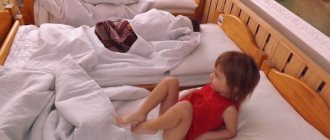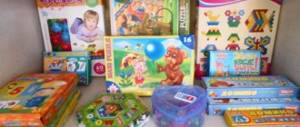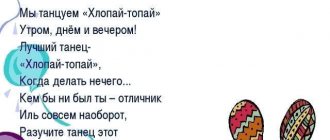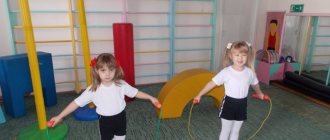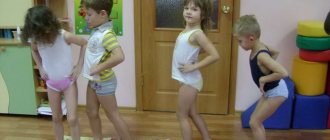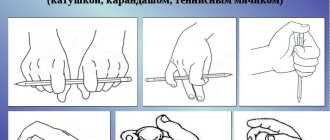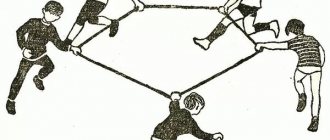The importance of gymnastics after waking up for preschoolers 4–5 years old
Awakening gymnastics (gymnastics after sleep, invigorating gymnastics) is a selection of exercises accompanied by soft music and rhymes, which helps organize the transition of children from sleep to wakefulness. When working with middle group children, exercises for awakening can be organized into a plot complex, where tasks are formulated on behalf of a fairy-tale character (toy). Physical activities are grouped together in such a way that the set contains the following tasks:
- from a lying position in bed (stretching, straight and cross swings of arms and legs);
- requiring active movements (walking, running at a moderate pace, squats, elements of finger games);
- from the breathing exercises block.
Gymnastics after sleep helps preschoolers harmoniously enter the wakefulness stage
On average, it takes 5–7 minutes to complete one complex. When considering the essence of the concept of gymnastics after sleep, it is also worth paying attention to the general educational strategy of the preschool educational institution: if the kindergarten operates according to a hardening system, then the awakening complex is carried out in the fresh air or with open windows in any weather.
Goals and objectives of performing gymnastics after sleep in the middle group of preschool educational institutions
Preserving and strengthening the health of young pupils is the strategic goal of the educational concept of teaching and educational activities in kindergarten. In this context, the mission of conducting a set of exercises after sleep is to:
- increasing muscle tone;
- improving the general emotional state of children;
- prevention of flat feet, disorders of the musculoskeletal system;
- increasing the intellectual performance of children;
- fostering the habit of proper transition from sleep to active activity through warm-up.
To achieve these goals, it is necessary to systematically solve such problems as:
- elimination of the consequences of sleep (drowsiness, lethargy);
- increased activity of the nervous system;
- stimulation of the respiratory, cardiovascular systems of the body, as well as the endocrine glands;
- preparation for the perception of physical and mental loads;
- developing a sense of camaraderie when performing tasks together, as well as when working in pairs.
The teacher needs to monitor the quality of the children’s movements: there should be no sudden movements during exercises after a nap. Otherwise, muscle strains, dizziness and overexcitation are possible. As in the second younger group, the accent elements of gymnastics after sleep for children 4–5 years old are:
- walking, running barefoot on tiptoes, on full feet;
- lifting.
Stretching, walking, breathing exercises form the basis of invigorating gymnastics
Types of invigorating gymnastics
In the middle group of kindergarten, the following types of complexes are practiced after sleep:
- exercises that are performed in bed (including self-massage), so-called lazy gymnastics;
- games (low mobility, finger games);
- exercises on simulators;
- running or walking on massage mats;
- corrective tasks or therapeutic and rehabilitation exercises (aimed at hardening the body, preventing disorders in the musculoskeletal system, etc.);
- breathing exercises;
- musical and rhythmic exercises with aerobic elements (usually developed by a physical education instructor).
It is worth mentioning separately about complexes in poetry: usually such blocks include elements of gymnastics of various types.
This is interesting. Any type of invigorating gymnastics involves calm musical accompaniment, for example, the sounds of nature.
Requirements for conducting
The Federal State Educational Standard (FSES) defines the rules for conducting invigorating gymnastics:
- The choice of complex after sleep should be focused on those activities that preceded the rest. For example, if before bed the kids played a role-playing game, then awakening gymnastics may include more active tasks (for example, running).
- The temperature in the bedroom should be maintained at 16–18 degrees.
- Since children do not wake up at the same time, it is worth preparing a self-massage complex for the “early birds.” For example, using massage balls.
- To perform gymnastics, children must wear panties and T-shirts. Shoes are usually not needed. However, if the exercises are carried out in winter or the complex includes elements of aerobics, socks or shoes are needed.
- Doing gymnastics is voluntary, so you shouldn’t force kids to complete tasks. Perhaps the child’s waking up routine is simply different. However, you still need to find out the reasons for the boycott by talking with your child one on one.
- For quarantined groups, loads are combined in accordance with the doctor’s recommendations. During the peak of a flu epidemic or acute respiratory viral infection, walking barefoot is usually excluded.
- During the summer, squatting and running tasks can be done outside.
In the summer, some of the exercises can be moved outside
Basic types of invigorating gymnastics and rules of conduct
Today, experts have invented many methods of invigorating gymnastics to awaken children. Among all this diversity, there are several that are most frequently used and effective. We are talking about verbal, visual, playful and practical exercises. Verbal awakening gymnastics consists of elements of logorhythmics, which are combined into one system of physical exercises to correct the child’s speech.
All movements must be accompanied by verses or phrases for the development of speech-motor and auditory analyzers. Also, during verbal gymnastics, breathing is regulated, motor skills are consolidated and the correct pronunciation of sounds is normalized. The first part of this exercise includes running and walking, and the second part includes movements that are accompanied by playful self-massages and poetry.
Objectives and goals of physical education
Note! As for visual gymnastics, it contains elements of corrective exercises. This type of exercise is designed to prevent the development of flat feet and eliminate postural disorders.
The main components are:
- exercises that form and strengthen the skills of correct posture;
- activities that form a stereotype and correct breathing.
The relative position of body parts is improved due to the respiratory muscles, so visual exercises are especially important.
Game gymnastics
A playful form of exercise helps children concentrate on performing exercises such as climbing over obstacles, running, jumping or catching a ball. The game is an indispensable tool that helps improve movement, coordination, speed, strength and endurance. During the game, memory, imagination and thinking are activated.
Important! Playful invigorating gymnastics should be accompanied by music, poetry or counting rhymes. Thus, children not only strengthen their physical fitness, but also expand their vocabulary.
Game exercises
Game exercises consist of introductory, main and final parts. The introductory part consists of easy running or various types of walking, as well as a game for concentration and exercises for the respiratory system. The main part includes a high level of mobility game, and the final part is designed to provide children with recreational activities and walking with breathing exercises.
Practical invigorating gymnastics
The practical form of training with children in most cases is represented by running, which is designed to regulate the load, strengthen the respiratory and cardiovascular systems, as well as coordinate the work of joints, muscles and ligaments.
Note! Running should be slow or moderate, during which the teacher needs to closely monitor each child so that he does not overdo the load, does not injure himself and rests in a timely manner.
The load must be increased gradually, taking into account the individual characteristics of each student and his physical fitness. For kids who have just entered kindergarten or have not attended classes for a long time, more than 50% load while running is contraindicated.
Techniques for performing gymnastics after sleep in the middle group of preschool educational institutions
The organization of work with invigorating gymnastics exercises is based on all types of methodological techniques traditionally used in the educational process of preschool educational institutions.
Group of verbal techniques
Calm, measured speech by an adult helps create an emotionally positive atmosphere of awakening. In addition, children at the age of 4–5, having mastered the sound and grammatical structure of the language, actively form their own speech image, relying on the models that surround them, that is, parents, kindergarten teachers. That is, the teacher’s word performs educational, developmental and educational functions, thereby pushing verbal methods of work to a leading position among other ways of organizing interaction with children.
Explanation
The tasks of the sets of exercises after sleep are not particularly complicated, but still, the execution of each movement must be clearly explained to preschoolers. To do this, short simple sentences are used that are in the nature of instructions: “Raise your right leg,” “Do not bend your knees,” etc.
Puzzles
This verbal technique is usually used as a means to motivate children to do a particular activity. But invigorating gymnastics has a special specificity: with its help, children are motivated for further activity, and besides, after sleep, children have a low level of concentration. You can motivate children to do physical exercises by influencing the emotional sphere, for example, by listening to musical sketches. Leave riddles as a technique for summing up the results of the work.
In my practice, after carrying out a complex that includes self-massage with balls, at the final stage of work, I suggest solving the following riddles:
- You hit the wall, and I'll bounce back. You throw me to the ground, and I’ll jump up. I’m flying from palm to palm, I don’t want to lie still. (Ball).
- A multi-colored bun, He will give you a hand, He is not afraid of pain, He loves to jump and roll! Who's jumping around like that? My funny round... (Ball).
This is interesting. Sometimes riddles precede the performance of a specific exercise. For example, “In a hanging cradle in the summer, a forest dweller sleeps” (walnut). Children lie on their backs, arms extended along the body. As you inhale, sit down without bending your legs. They reach their toes with their feet and exhale.
Riddles can precede the exercise
Poems
This verbal technique is traditionally used for motivation and fits perfectly into the initial stage of invigorating gymnastics, that is, the actual awakening of children. Rhymes should be short, with a clear rhythm.
When working with middle school children I use the following:
- Look quickly what time it is! Tick-tick, tick-tick, tick-tick! Left once, right once! Tick-tick, tick-tick, tick-tick!
- A steam locomotive runs along the rails, taking us to exercise.
- We rested peacefully, fell asleep in a magical sleep. It's good for us to rest! But it's time to get up! We clench our fists tightly and raise them higher. Stretch! Smile! Everyone open their eyes and stand up!
Like complexes for morning exercises, exercises after sleep can also be in poetic form. But it is appropriate to conduct such gymnastics when all the guys have woken up, that is, they can simultaneously get into work.
Table: examples of invigorating gymnastics in verse for the middle group
| Name | Poem text |
| "Bear" | Bear, raise your paws, Bear, put your paws down. Bear, Bear, spin around, and then touch the ground. And rub your tummy: One, two, three; one two Three! |
| "Wake up and smile" | The eyes open, the eyelashes rise. (Light facial massage) Children wake up and smile at each other. (Turn their head left and right) Breathe evenly, deeply and freely, and easily. (They take a deep breath and exhale, inflating and drawing in the stomach) What a wonderful exercise! How it helps us, improves our mood and strengthens our health. (Rub your chest and forearms with your palms) Clench your fists tightly and raise your arms higher. (Slowly raise their hands up, quickly clenching and unclenching their fists.) Stretch really, really hard. Smile wider at the sun! (Holding out their arms, stretching) Let's stretch! Smile! Finally we woke up! Good afternoon It's time to get up! Make your bed. |
| "Let's play" | Guys, wake up! Eyes, open! Legs, stretch! Hands, rise up! We will first take very small steps. And then take a wider step. Like this, like this. Stand on your toes, stretch your arms up. Raise your legs higher and walk like a heron. The planes sat at the airfield, and then they took off. They flew through the sky for a long, long time, then landed - they were tired. The ball jumped high, high... It rolled far, far... It spun like a top, and then it stopped. Oh, how butterflies fly and dance and flutter. Suddenly they freeze, don’t move, and sit on a flower. Finally we woke up and returned to our business. |
| Quote from: https://stydopedia.ru/2xd00e.html | |
While performing gymnastics, children can pretend to be a bear, a butterfly, an airplane, etc.
Fairy tales
Children love to fall asleep to a fairy tale - this is an axiom. From my own experience, I was convinced that interesting stories can be perfectly integrated into a set of tasks for awakening. True, you should not overload the plot with questions about the content after listening: 1-2 tasks of a reproductive nature will be enough. The fact is that kids are included in the essence of the story depending on how quickly they come out of sleep, besides, the time for the transition from sleep to wakefulness is limited, and you still need to have time to complete the exercises. This is why you should not choose long fairy tales. One of my students’ favorites is the story about colorful men. “A mysterious story once happened in a kindergarten. The children woke up and could not find their favorite toys. But we saw an orange door near the closet with toys. The boy Vanya opened it and went in, and there he was met by a blue bird. When Vanya told her that children could not find their toys after sleep, Bird explained that colorful people take their favorite bears and dolls. The fact is that when the guys sleep, their dreams are in the form of little gnomes of different colors, living in the country of Splyandia, so as not to get bored, they take toys. And when the children wake up, the little men return the dolls to their place. But if the kids sleep for a long time and don’t want to wake up, the colorful little people begin to be capricious and refuse to return the toys. That is why it is important to fall asleep in time to give the gnomes the opportunity to play, and at this time for the children to have colorful dreams, and to wake up in time to get their toys back. Vanya understood what was going on, returned through the orange door and told the guys how it happened. Since then, the kids quickly fall asleep and, without being capricious, wake up quickly and easily.” After listening to the story, the children can be asked to answer the following questions:
- What happened in one kindergarten?
- Why is it important to fall asleep and wake up on time?
Storytelling can be replaced by reading.
A fairy tale helps organize kids and attract their attention to doing exercises.
This is interesting. Invigorating gymnastics for children learning a foreign language can be performed in English.
Video: gymnastics after sleep in English
https://youtube.com/watch?v=miSn4qmGLH4
Group of visual techniques
In preschool age, vision is the leading channel of perception of the world. Therefore, the use of visual techniques in the organization of any type of activity is a prerequisite for a successful educational process. To carry out gymnastics after sleep, the following types of visualization are used:
- pictures illustrating the progress of the exercises (it is convenient to use them in individual work with children who make mistakes when completing tasks);
- demonstration by the teacher of the procedure for completing the task (in the middle group, your own example when working on the complex is appropriate for 1-2 repetitions, then it is enough to remind the children of the course of the exercise);
- showing a video (one of the most favorite visual techniques for kids, the essence of which is to repeat the movements of the characters in the video).
Video: warming up with a pillow
Practical techniques
These methods of interaction with children imply the materialization of one or another educational material. Regarding gymnastics after sleep, these will be:
- actually doing the exercises;
- drawings, applications related to the content of the complex (for example, after completing the “Bear Cubs” block, the children draw or make an application of geometric shapes on the topic);
- crafts.
In addition to repeating the movements of gymnastics, other practical techniques are implemented not at the time of its implementation, but during the rest of the day. Typically, such tasks are given to students as independent work.
Practical tasks help children remember what exercises they did
Gaming techniques
Since play is the main activity of preschoolers, it is impossible to do without techniques based on performing play actions. In relation to gymnastics after sleep, the game is used as a form of exercise. Games usually either start a complex, that is, are held when the kids are still in bed, or complete a block of tasks.
This is interesting. To conduct invigorating gymnastics, games of low mobility or, as they are also called, games of good mood are chosen.
Table: examples of games for invigorating gymnastics in the middle group
| Author | Posunko N.V., physical education instructor, KGKP Ya/Garden No. 25, Ekibastuz, Kazakhstan. |
| Name | Content |
| "Zucchini" | (Children lie on their backs, legs bent at the knees, standing on the bed) Zucchini lies in the garden bed and tries to grow. (They straighten their legs and put them on the bed) The sun gently warms them, (They raise their arms up, spread them to the sides, put them on the bed with their palms up) And give them rain to drink. (They raise their hands up in front of them and make waving movements with their hands and fingers) They were tired of lying, and they all decided to run away from the zucchini patch together. (The fingers are clenched into fists. Circular movements of the arms bent at the elbows, imitating the “Bicycle” exercise.) But very dexterous guys caught them by the heels. (Slowly sit down, lean forward and touch the soles of their feet) They picked up the zucchini, (Get out of bed and wrap their arms around themselves) And then gave it to their mother. (Stretch both hands forward). |
| "It's me" | These are the eyes. Here. Here. (Children point first to the left eye, then to the right eye) These are ears. Here. Here. (Take first the left ear, then the right) This is the nose. This is the mouth. (With the left hand they point to the nose, with the right hand to the mouth) There is a back. There's a belly here. (The left palm is placed on the back, the right palm is placed on the stomach) These are the handles. Clap clap. (Stretch both hands forward and clap twice) These are the legs. Top. Top. (Put their palms on their hips, stomp their feet) Oh, we’re tired - let’s wipe our brow. (The right palm is passed over the forehead.) |
| "Vegetables and fruits" | Children stand in a line or scattered around the hall. The teacher names various vegetables (the children must quickly sit down) and fruits (raise their hands). Those who made mistakes take a step forward. The children who make the fewest mistakes win. |
| Quote from: https://kopilkaurokov.ru/fizkultura/prochee/ighry-dlia-khoroshiegho-nastroieniia-malopodvizhnyie-ighry-dlia-dietiei-doshkol-nogho-vozrasta | |
Methods of conducting invigorating gymnastics in the middle group
As a rule, preschool teachers, when compiling sets of exercises after sleep, are guided by the principle of covering all the goals and objectives of performing gymnastics. However, in practice, due to the need to meet a time frame and at the same time practice this or that action, it turns out that planning includes sets of exercises to solve 2-3 specific problems. For example, self-massage and prevention of flat feet or a set of sports games, breathing exercises, etc. In the middle group, about 2 weeks are allotted to practice one complex, respectively, per month the children master 2 blocks of invigorating gymnastics exercises.
Pupils of the middle group master two sets of exercises per month
Table: example of compiling awakening gymnastics complexes (fragment)
| Author | Zdorova G. A., teacher of the State Budgetary Institution NSO Center for psychological, pedagogical, medical and social assistance to children “Regional Center for Diagnostics and Consulting”, Novosibirsk. | |||
| Month | Name of the complex | Type of exercise | Exercise name | Description |
| October | "Walk in the Woods" | In bed | "Stretch" |
|
| Exercises to train the musculoskeletal system | "Slide" |
| ||
| “Here the Christmas tree bent over, green needles” |
| |||
| “Here is a tall pine tree standing and moving its branches.” |
| |||
| “Children in berets fell from a branch and lost their berets” (acorns). |
| |||
| “Alena is standing, green foliage, thin figure, white sundress” (birch). |
| |||
| Prevention of flat feet |
| |||
| Breathing exercises | "Geese" | As you inhale, bend forward: looking forward and stretching your neck, say “sh-sh-sh.” | ||
| "Geese-swans are flying" |
| |||
| "I'll grow big" |
| |||
| "Breathing with our bellies" |
| |||
| "Fungus" |
| |||
| May | "Bug" | Gymnastics in verse |
| |
| Prevention of flat feet | Walking barefoot on a massage mat. | |||
| Quote from: https://nsportal.ru/detskiy-sad/zdorovyy-obraz-zhizni/2016/11/12/gimnastika-probuzhdeniya-sredniy-vozrast | ||||
Gymnastics time plan
As noted above, 5–7 minutes are allotted for invigorating gymnastics. The work is distributed between three stages:
- introductory;
- main;
- final.
Table: approximate timing of gymnastics after sleep
| Stage | Type of work | Time |
| Introductory |
| 1–1.5 minutes |
| Basic | General developmental physical activity, including for the prevention of flat feet. | 2–3 minutes |
| Final | Breathing exercises. | 2–2.5 minutes |
| Hardening procedures, if they are provided for by the strategy of the educational process in the preschool educational institution. | The timing is calculated depending on the essence of the procedure, as well as the required time for preparation, for example, undressing children, preparing water for dousing, etc. |
The timing of the final stage of invigorating gymnastics does not include the process of dressing
Table: example of a summary of awakening gymnastics in the middle group (fragment)
| Author | Prokhorova A.L., teacher at MBDOU No. 196, Ivanovo. |
| Introductory stage | To the music “He who woke up early is a cockerel.” Tili-don, tili-don, What is this strange chime? Then our alarm clock rings, telling us to wake up. |
| Main part | I’ll push away the remnants of sleep, put the blanket aside (The guys sit down and move the blanket to their feet. They lie down on the bed, arms along the body) We need gymnastics, it helps a lot. (Hands up from side to side, stretch, lower arms) We woke up, stretched, turned from side to side, and stretched again. (Turns the torso left and right. Arms up from side to side, stretch, lower arms) And now one more time: Turn from side to side And stretch again. (Turns the torso left and right. Arms up through the sides, stretching) We raised our legs and stood on the pedals. I turn the pedal faster and I swing, I swing, I swing. (Lying on your back, raise your legs and put them on the pedals, perform “bicycle” movements) We found ourselves in a meadow. Colorful wings flutter, These are butterflies flying. (They sit on the bed, legs straight, waving their arms) Let’s stand by the bed together and look out the window. A rooster walked through the yard and shouted to us: “Ku-ka-re-ku.” (They stand on the floor by the bed. They look out the window. They walk in place and shout “ku-ka-re-ku”) <…> |
| The final stage | The guys walk on the massage mat, massaging their feet. Then along the wet path and then on the dry one. After this, the children go to get dressed. |
| Quote from: https://nsportal.ru/detskiy-sad/zdorovyy-obraz-zhizni/2016/06/01/konspekt-gimnastiki-probuzhdeniya-posle-dnevnogo-sna-v | |
Video: gymnastics after sleep with elements of self-massage
Analysis of invigorating gymnastics with middle preschoolers
Exercise monitoring after sleep is carried out:
- as an element of drawing up a general diagnostic chart of the physical development of children in a specific group;
- to assess the level of methodological literacy of the teacher when conducting invigorating gymnastics.
Diagnostics are carried out both by methodologists, the teacher’s colleagues, and by the teacher himself to identify shortcomings in performing the exercises. In both cases, the analysis scheme will be the same.
When conducting the analysis, the physical capabilities of children and the level of methodological literacy of the teacher are taken into account.
Before analyzing the actual content of the exercise block, you must indicate:
- full name of the preschool educational institution and the group whose work is being diagnosed;
- teacher's name;
- the date of the gymnastics;
- the total number of children in the group, as well as those present during the exercises.
Table: analysis of the content of a set of exercises after sleep
| No. | Gymnastics stage | List and description of exercises | Time frame | Conclusion (goals achieved or not) | Notes |
| 1 | Organizational moment (beginning of the ascent, toilet) | 2 minutes | |||
| 2 | Exercises in bed | ||||
| 3 | General developmental exercises | 3 minutes | |||
| 4 | Breathing exercises | 2.5 minutes | |||
| 5 | Hardening procedures | The time frame depends on the nature of the procedure |
Gymnastics after sleep is of great importance not only for the general physical development of children, but also for creating a positive emotional background. In the middle group, the mood factor plays a significant role for the successful manifestation of children in one or another educational activity. In addition, many babies, after waking up, begin to miss their mother even more, and fun exercises accompanied by calm music help take their minds off their worries. Considering the scale of the tasks being solved, the teacher should carefully consider both the structure and content of invigorating gymnastics.
The need and benefits of gymnastics
Gymnastics plays an important role in human physical development. Workouts performed after sleep during the day are a set of measures that make it easier to switch from getting up to being awake. When performed correctly, they have a healing focus.
When a person sleeps, all processes in the body slow down. Upon waking up, reaction speed, mental and physical activity, and sensitivity in the nervous system are reduced.
Lethargy may be present from 10 minutes to 2-3 hours. Such a long switch of the body is harmful to health, especially for children.
Sounds and visual signs encourage awakening. Before starting gymnastics, it is advised:
- open the curtains;
- open the window;
- put on a melodic musical composition;
- do exercises.
The warm-up ends with hardening procedures, which include running on massage, wet paths, rubbing with cool water, and dousing.
These activities will help improve the function of the nervous system and bring the transition to an alert state closer.
The main goals of invigorating gymnastics after a nap:
- relieve the effects of sleep (drowsiness, lethargy, lethargy);
- activate the body's systems and set them up for intense activity (heart, blood vessels, breathing);
- develop physical skills;
- prevention of colds and musculoskeletal system.
Thanks to gymnastics in bed, the work of the heart muscle improves, blood flow and respiration increase, which contributes to an improved supply of nutrients and oxygen to the cells.
High-quality corrective exercises will relieve a sleepy, lethargic state, weakness, increase intellectual and physical ability, mood and disposition, and improve the health of the entire body.
